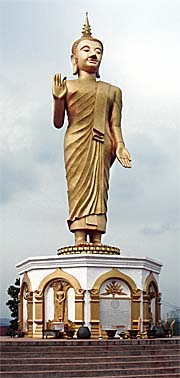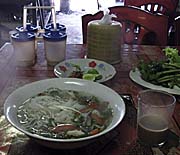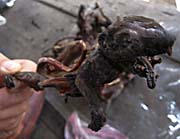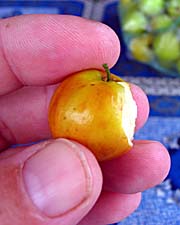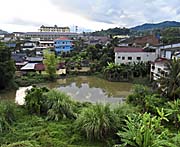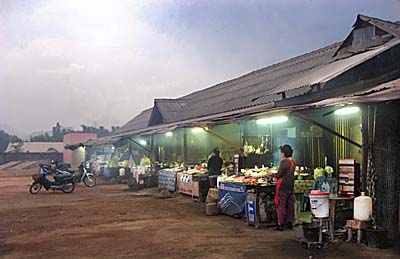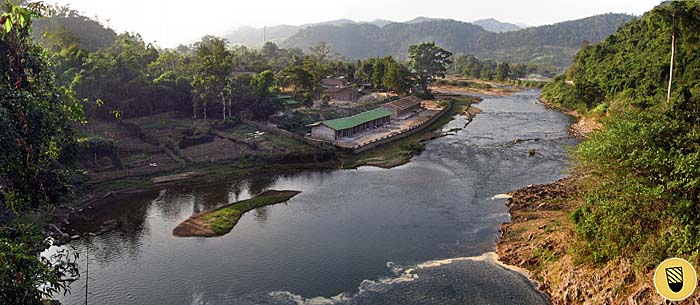1.
Province of Oudomxay
Northern Laos is coined by mountainous surroundings with elevations between 300m and 1,800m above sea level. Rich in waterways, there are about sixty rivers leading through Oudomxay Province. The local population consists traditionally mostly of tribal people (Khmu, Lao Loum, Hmong and many others). In the last years more and more Chinese traders came into Laos and started businesses and settled down. So, a strong Chinese influence is also to see in Oudomxay/Muang Xay.

Muang Xay, the provincial capital, also frequently called Oudomxay, seen from the temple mountain. Image by Asienreisender, 2010
The province of Oudomxay lies in central north Laos, and it's province capital Muang Xay (also frequently called 'Oudomxay') is the main traffic hub for the north. Any traveller who comes from Luang Prabang and is heading further northwards can hardly avoid Muang Xay / Oudomxay, at least when travelling by busses. The northern places as Luang Namtha, Phongsali or even Huayxai (Bokeo Province) are accessable via Oudomxay. Also a road to Ban Pak Beng, which is going to be linked by a bridge to continue southwards to the border point of Muang Ngeun to Thailand's Nan Province starts in Oudomxay.
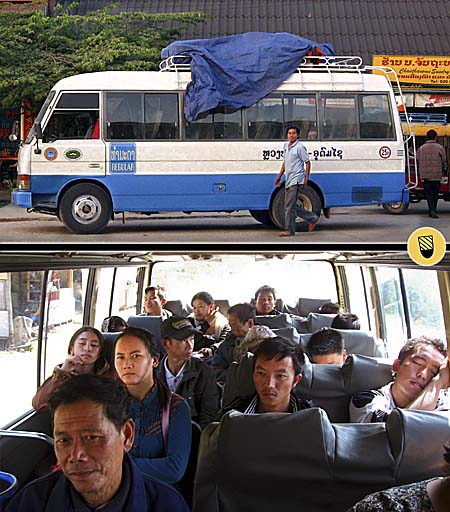
A typical Laotian bus (Made in China) from outside and from inside. That's all not looking too bad, for the bus is not yet overcrowded. On the way the vehicle stops multiple times and picks more new passengers up than others leave. They bring goods and animals with them and it gets more and more crammed...
Images and photocomposition by Asienreisender, 2010/2014
Nevertheless, few tourists or travellers stay here for a night or more, except they have to wait for a bus connection next morning. Others might come here to do mountain trekking, for the tourist industries started recently to offer guided tours, labelled as 'ecotourism'. Tourism is increasingly promoted in the last years by the Laotian authorities.
This whole part of Laos is very interesting and fascinating for Westerners from developed countries because it's just the opposite of what we know: it's pretty undeveloped. A great number of people here live like they did in previous centuries: in simple housings without electricity and supermarkets, in an agricultural subsistence economy. Many of the province's remote villages are isolated and have no road access. The traditional way to move around here was since the oldest times the waterways on the many rivers. Once a week some villagers come down to the valleys and sell their goods on local marketplaces, of whom Muang Xay is only one out of many.
Economy
The main agricultural product of the local economy is dry rice, mostly grown in the traditional way of slash-and-burn jungle slopes. Wet rice cultivation requires plains with an irrigation system. Oudomxay is not rich in such plains as the regions along the Mekong River are. The dry rice paddies usually have no irrigation system; they depend on rain.
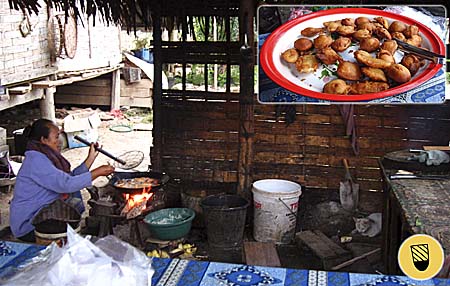
Inside a street restaurant in Muang La. Dough is fried on an open fire, burned with coal or firewood from the surrounding forests. The baked pieces are pretty fat respectively oily. Sometimes they are filled with fruits or anything else, but normally not. The paste is made of rice flour. Images and photocomposition by Asienreisender, 2010/2014
Apart from rice there is corn, soy, vegetables, fruits, maniok, coffee, sugar cane, tobacco, cotton, tea and peanuts produced in Oudomxay's soil. Some of the products are merely cultivated as cash crops for the export industries. Oh, one shouldn't forget the traditional poppy cultivation. Oudomxay is part of the greater Golden Triangle and therefore famous for opium (and later heroin) production.
As everywhere in rural Laos water buffalos, pigs, cattle, chicken, ducks and other livestock is kept. Together with river fish it makes part of the local economy and particularly provides the protein sources for the people.
Gathering and hunting in the forests is still common here. Though, of the riches of the natural habitats are only estimated 12% of the forests still primary rainforest, while 48% are secondary forest. Another part is plantation economy, means monocultures of teakwood, rubber and other timber.
However, Laos lacks the industries for processing the agricultural products. That leads to a dependency to foreign, namely Chinese industries, who buy the products and refine them. The ready-products might be reimported then partially.
The mountains of Oudomxay also provide a number of minerals.
By the way: the village Ban Pak Beng, actually a stopover at the banks of the Mekong River, is also situated in Oudomxay Province.
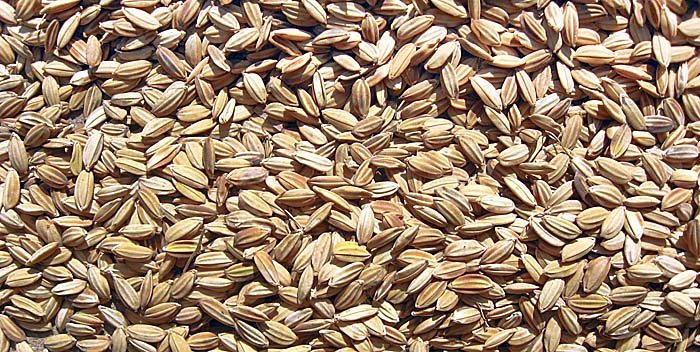
Rice corns exposed to the sun for drying. Rice is the food basic in all the Southeast Asian countries as it is wheat in the west. A great part of the people are rice farmers. Alledgedly there are some 4,000 different kinds of rice cultivated in Laos. In Oudomxay Province it's mostly dry rice.
Image by Asienreisender, 2010
